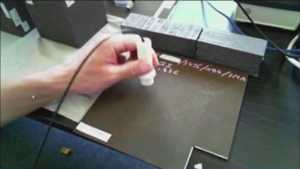
This nondestructive measurement applies to the following materials:
- Carbon composite materials (CFRP, carbon fiber reinforced plastic)
- Graphite
- Plastics or elastomers plated or doped with metallic particles
In the case of carbon composites, electrical conductivity can be an indicator of the proximity between carbon fibers.
Electrical conductivity is an essential quality of graphite because this material is often used for manufacturing electrodes.
More and more often, conductive plastics or elastomers are encountered in life. Initially, these materials are not conductive, but manufacturers add a small amount of metal particles in their composition to give them special physical properties. In the case of vehicle construction, for example, the conductive elastomer constituting the tires makes it possible to evacuate the electrical energy supplied during a lightning strike, or to dissipate the static electricity accumulated during a journey, eliminating electrostatic discharges which are uncomfortable for people and dangerous for electronic devices.
In the aerospace industry, carbon composite materials are increasingly used instead of aluminum or titanium thanks to their low weight and high mechanical strength. However, carbon composites are poor conductor and cannot effectively protect the aircraft in case of electromagnetic disturbance or lightning. Techniques for doping or plating metal particles are under development in order to ensure the necessary minimum electrical conductivity for carbon composites.
The video below (https://youtu.be/meFOrx773QE) shows how the Z-Scope*7 from Sciehttps://www.sciensoria.fr/en/measurement-of-electrical-conductivity-of-graphite-by-the-eddy-current-method/nsoria can measure electrical conductivity of a plate of carbon composite (CFRP: carbon fiber reinforced plastic).
The Z-Scope*7 has also been used for determine electrical conductivity of graphite, or metallic powder used in 3D printing.
The measurement of electrical conductivity by the eddy current technique is safe and simple to implement. The electromagnetic field induces eddy currents everywhere in the volume to be measured, unlike measurement with contact points where the injected current does not necessarily pass through the entire volume studied. This is all the more true in a material where the zones of conductive materials are alternated with the zones of insulating materials, as is the case with carbon composites. There is no use of electrodes, so the measurement error due to bad electrode contacts no longer exists. And, last but not least, this measurement technique is nondestructive. It does not alter the quality of the measured product.
